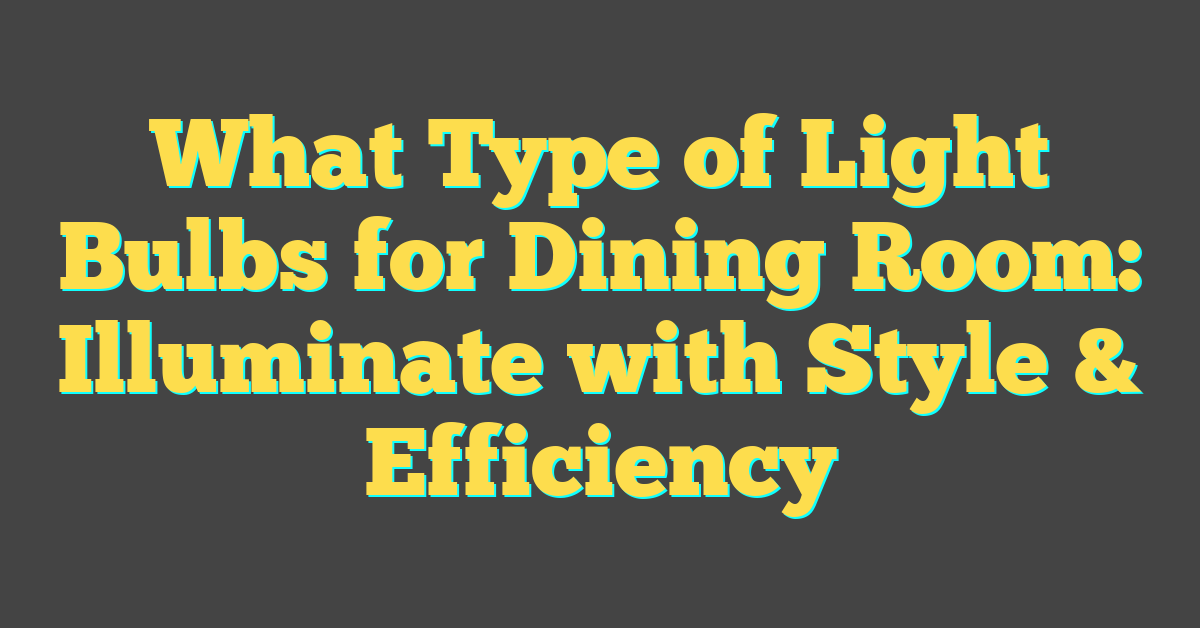Choosing the right light bulbs for your dining room isn’t just a matter of brightness; it’s about setting the perfect mood for your meals and gatherings. The options can be overwhelming, but don’t worry—you’re about to make an enlightened decision.

Think about the ambiance you want to create. Do you envision a warm, cozy dinner or a bright, lively feast? The type of bulb you pick can make all the difference. Let’s dive into the world of lumens, color temperatures, and bulb shapes to find your dining room’s ideal match.
Consider the ambiance
Imagine your dining room not just as a space for eating, but as a stage where lighting sets the scene for every meal. Here’s the thing: The ambiance in your dining room is pivotal—it’s all about creating a mood that complements your gatherings. Whether it’s family game night or a formal dinner party, the right light can transform your dining experience.
When you’re picking out bulbs, think about the vibe you’re aiming for. Do you want a warm, cozy glow that invites guests to relax and stay awhile? Or are you looking for a lively brightness that energizes the room and sparks conversation? Your choice of light really lays the groundwork for these moods.
To nail that warm feeling, you’ll want to lean towards lower color temperatures—think in the range of 2,700 to 3,000 Kelvin. These mimic the toasty hues of candlelight and are like a visual hug for your space. On the flip side, to invigorate your dining room with a more vibrant atmosphere, choose bulbs with a higher color temperature, around 3,500 to 5,000 Kelvin, which resemble the midday sun.
And let’s not forget about lumens—the measure of brightness a light bulb provides. This is where you balance how much light you need with how it plays with your room’s features. Here’s a quick breakdown to guide you:
| Desired Ambiance | Lumens Range |
|---|---|
| Intimate and Cozy | 200-400 Lumens |
| Bright and Sociable | 400-800 Lumens |
| Task-Oriented and Clear | 800+ Lumens |
You might also want to consider dimmable options. They’re perfect for those times when you need to adjust the lighting to match the mood mid-event—no need for a lighting intermission when you’ve got the power at your fingertips!
But there’s more to the puzzle. The shape and appearance of bulbs count too. Take, for instance, the classic A19 bulb—versatile and timeless, it’s a go-to for many. Yet, something like a globe bulb, or G-shape, can offer a dash of modernity while distributing light evenly.
Understanding lumens and color temperatures

When you’re on the hunt for the ideal light bulbs for your dining room, grasping the basics of lumens and color temperatures is crucial. Think of lumens as the amount of light emitted by a bulb. In simple terms, more lumens mean a brighter light, fewer lumens equate to a dimmer light. Dining rooms generally require a range of 2000 to 4000 lumens to be adequately lit. This creates an inviting space without overwhelming guests with too much brightness.
| Lumens Range | Suggested Room Use |
|---|---|
| 1000 – 2000 | Cozy, intimate |
| 2000 – 3000 | Casual dining |
| 3000 – 4000 | Vibrant gatherings |
Moving onto color temperatures, they’re measured in Kelvins (K). The lower the Kelvin number, the warmer and more yellow the light will be. Conversely, higher Kelvins give off a cooler, bluer light. For a dining room where you want to strike a balance between a cozy and a welcoming atmosphere, aim for a soft white range from 2700K to 3000K. Here are some quick temperature guidelines:
- Warm White (2000K – 3000K): Perfect for relaxing and entertaining, giving off a warm glow ideal for evenings.
- Bright White (3500K – 4100K): Mimics daylight and is good for task lighting when sharp visibility is needed.
- Daylight (5000K – 6500K): Resembles natural sunlight, best used in spaces requiring high levels of concentration and crystal-clear lighting, not typically recommended for dining rooms.
Remember that beyond lumens and color temperatures, you should also consider the CRI (Color Rendering Index), which indicates how true to life the colors appear under the light. A CRI of 80 to 90 is generally good for most home uses. With these guidelines, you can confidently narrow down your options and pick light bulbs that will complement your dining room’s ambiance and décor. Experiment with different combinations and find what works best for your space and the moods you wish to set.
Brightness vs warmness

When you’re picking out the perfect bulbs for your dining room, understanding the balance between brightness and warmness is crucial. It’s not just about lighting up the space; it’s about creating the right feel for every meal and moment.
Brightness is measured in lumens. For your dining room, you want a bulb that offers enough lumens to illuminate the table without overbearing glare. Think soft light, not surgery room. On the other hand, warmness refers to the color temperature of the light, indicated in kelvins (K). Lower kelvins mean warmer, more yellow light, creating an intimate and cozy atmosphere.
« What Light Bulb for Fridge? The Best Guide to Brighten Your Cold Storage
Where Is Light Bulb in Fridge? Quick Guide to Find & Fix It »
Here’s a quick guide to help you strike the right balance:
- Casual Dining: 2,000-3,000 lumens combined with a color temperature of about 2,700K.
- Elegant Dinners: 1,500-2000 lumens with warmer light, around 2,200K to 2,400K.
- Everyday Use: Aim for 3,000-4,000 lumens paired with a neutral 3,000K to 3,500K for sufficient visibility during mundane tasks.
Remember, dimmable bulbs are your best friend when it comes to adjusting both brightness and warmness. They let you dial in just the right level of illumination for slicing into a steak or unwinding over a glass of wine.
The shape of the bulb also matters when playing with brightness and warmth. Wider bulbs distribute light more evenly, lessening shadows and hotspots, whereas narrower bulbs concentrate light, which can be used to spotlight the centerpiece or the meal itself.
Choosing the right color temperature also means considering the time of day. For example, midday light is natural and bright is suitable for lunch, whereas evening dining calls for golden hues to match the sunset’s warm glow.
With these tips, you’ll achieve a dynamic lighting scheme in your dining room that’s as functional as it is atmospheric. So grab a few options, test them out, and see how different lighting combinations transform your space.
The role of bulb shapes

When you’re thinking about the perfect light bulbs for your dining room, never underestimate the power of the bulb’s shape. Each silhouette—from spherical to tubular to flame-shaped—has a unique effect, something you’ll want to leverage to create your ideal setting.
Standard shapes like A19 bulbs are your go-to choice for general lighting. They spread light evenly and illuminate large areas, which is essential when you’re hosting a big dinner party.
If you’re aiming for a cozier atmosphere, perhaps for an intimate, romantic dinner, consider globe-shaped bulbs (G series) to create a soft, diffused glow that’s inviting and warm.
On the other hand, candelabra bulbs, with their slender, decorative design, fit perfectly in chandelier fixtures. They give off a classic and sophisticated vibe that’s just right for elegant dining experiences. Remember, though, they tend to provide less light, which is something to consider if you’re looking for functionality as well as style.
Don’t overlook vintage Edison styles if your dining area embodies a rustic or industrial feel. These bulbs often feature visible filaments that add character and a touch of nostalgia, which can take your decor to the next level.
For a modern space, T series tubular bulbs can provide a more focused light that’s ideal for highlighting centerpiece décor while still being practical enough to eat by.
Adjustable track lighting with PAR or MR bulbs is a great option to consider when you want directional light that can accentuate wall art or shelving while still contributing to the overall brightness of the room.
Keep in mind the harmonious interaction between bulb shapes, light spread, and shadows. Playing with different shapes can bring layers and texture to the room’s lighting. Each shape can serve a purpose, whether you’re lighting a lavish spread or settling down for a quiet meal.
Experiment with various combinations to discover how bulb shapes can complement your dining room’s decor and vibe. After all, as a DIY enthusiast, the joy is in the creation of a space that feels uniquely yours.
Choosing the perfect light bulb for your dining room

When it comes to choosing light bulbs for your dining room, you’re not just buying a product; you’re setting the stage for countless memorable meals and conversations. A well-chosen light bulb does more than illuminate; it enhances the beauty of the space and the comfort of your guests.
Color temperature is one of the first things you’ll want to consider. Measured in Kelvins, color temperature affects the warmth or coolness of the light. Warmer tones, typically around 2700K to 3000K, create a cozy, inviting atmosphere, ideal for dining areas where you want guests to feel at home. On the other hand, bulbs with a higher Kelvin count emit a cooler light that’s better suited for offices or kitchens.
Next, focus on the brightness, measured in lumens. For dining rooms, you don’t want the light to be too harsh. Look for bulbs offering lumens in the range of:
| Setting | Lumens |
|---|---|
| Soft Ambient | 200 – 400 |
| Bright Social | 400 – 800 |
| Task Lighting | 800 and above |
Remember, a dimmer switch can offer great versatility, enabling you to adjust the brightness to suit any occasion.
Another key aspect is the beam angle. Bulbs like spotlights with narrow beam angles are a no-go for dining areas. You’re aiming for bulbs that spread light evenly, creating a welcoming glow across your entire dining table. Options like frosted or opal bulbs can help achieve this diffusion, avoiding harsh shadows and glare.
Don’t overlook the shape and appearance of the bulb itself, as you can see from the examples in the previous summary. The aesthetic of the bulb should complement your dining room’s decor. Unique bulbs like the vintage Edison style might just be the conversation starter you need at a dinner party.
Feel free to get a bit experimental. Sometimes, the best lighting setup comes from trial and error. Mix and match different bulb shapes and temperatures to discover the ideal combination that reflects your personal style and enhances the functionality of your space. Remember to consider energy-efficient options like LED bulbs that offer the double benefit of conserving energy and cutting costs in the long run.
So grab some bulbs and start illuminating the heart of your home with style and warmth. Lighting is an art form, and your dining room is the canvas.
Conclusion
Now that you’ve got the scoop on the best light bulbs for your dining room, you’re all set to cast the perfect glow over your next meal. Remember, it’s all about the mood you want to set. So whether you’re going for a soft, cozy vibe or a clear, focused light, the right bulb is out there. Don’t be afraid to mix and match shapes and temperatures to tailor the atmosphere to your taste. And while you’re at it, opting for LED bulbs can save energy, making your dining experience not only beautiful but also eco-friendly. Get ready to dine in the best light possible – your perfect ambiance awaits!
Frequently Asked Questions
What factors should be considered when choosing light bulbs for a dining room?
The key factors include the color temperature and lumens for the desired ambiance, whether the bulbs are dimmable, and the shape and appearance of the bulbs to achieve the preferred lighting effect.
How does lighting influence the mood in a dining room?
Lighting plays a crucial role in setting the mood by creating a welcoming and comfortable atmosphere tailored to different occasions, from casual family dinners to elegant social gatherings.
What color temperature is suitable for a dining room ambiance?
A warm color temperature, typically around 2700K to 3000K, is recommended to create a cozy and inviting ambiance in a dining room.
Why are lumens important in choosing a dining room light bulb?
Lumens measure the brightness of a bulb. The right amount of lumens contributes to the overall ambiance by providing sufficient light without being too harsh or too dim.
What are the benefits of using dimmable bulbs in the dining room?
Dimmable bulbs offer flexibility to adjust the intensity of light to match the mood and time of day, making them versatile for different dining experiences.
Can the shape of a bulb affect the dining room ambiance?
Yes, bulb shapes can impact the lighting effect. For example, A19 bulbs are great for general lighting, globe-shaped bulbs create a cozy feel, and candelabra bulbs add elegance to dining settings.
Are LED light bulbs a good choice for dining rooms?
LED light bulbs are an excellent choice due to their energy efficiency and long lifespan, potentially reducing energy costs and needing fewer replacements over time.




